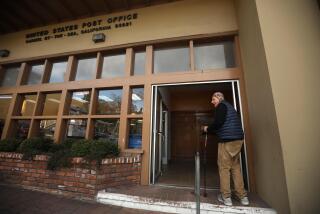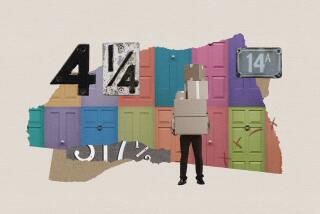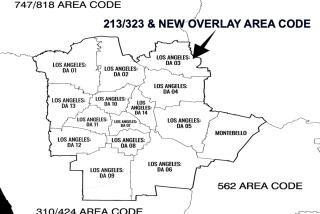Opponents of Proposed Area Code Split Put Their Anger on the Line
- Share via
Sometimes the dividing line between the past and the future is hard to see. But Art Aerapetyan has seen the future and he couldn’t be more miserable.
If a proposed 818 telephone area code split goes through as planned in June 1997, one boundary line will be Clybourn Avenue, and Aerapetyan’s Mat Auto Body shop in Burbank is on the wrong, or east side, of that street. So his phone number, along with 2.8 million others, will be switched to the new 626 area code.
Meanwhile, 20 yards across the street is another auto repair shop that will keep its 818 phone number. “Very unfair,” Aerapetyan said.
“People are going to be afraid to call me because they think 626 is a long distance call,” he said. “They might think 626 is in San Diego or something.”
He also faces $2,000 in out-of-pocket costs to change phone numbers on his business cards, advertising fliers and receipts. “That’s a lot of money,” he said, for a small business that is struggling.
It is one reason why Burbank and Glendale have teamed up to try and push the boundary line farther east so both cities can remain in 818. “Otherwise, we’re talking about splitting apart an entire community [the San Fernando Valley] that Burbank has been identified with for decades,” said Terry Stevenson, Burbank’s senior assistant city attorney.
Part of the proposed area code boundary snakes along the western edge of Burbank. West of that line, the phone numbers remain 818; east of it, including Burbank, Glendale, La Canada Flintridge, Pasadena and into the San Gabriel Valley, would become 626.
Adding to this legal tangle is a complaint filed by Monterey Park. The city contends that San Gabriel Valley businesses employ more workers, and their work forces will grow faster in the next 15 years, than those in the San Fernando Valley. Because businesses pay most of the costs of an area code change, Monterey Park says the new area code plans should be flopped, with the San Fernando Valley getting 626.
All this legal squabbling is fallout from the telecommunications boom and the uncontrollable surge in phone numbers, from fax machines to cellular phones, beepers and pay-at-the-pump gas station credit cards.
In 1947, there were three area codes in California; today there are 13. By 2000 there will be 26 area codes, and the 818 area code is expected to run out of new phone numbers by June 1998.
Administrative Law Judge Philip Weismehl has consolidated the Burbank-Glendale and Monterey Park cases. He is not expected to make his ruling before September. After Weismehl’s decision, the state Public Utilities Commission will make the final ruling, but probably not until October. And the PUC could overturn Weismehl’s decision.
Helen Mickiewicz, an attorney with the PUC’s Division of Ratepayer Advocates, expects that Weismehl will leave the 818/626 area code boundaries as they were proposed. Attorneys for Burbank-Glendale and Monterey Park have made a good argument, she says, “but it has to be a compelling argument” to alter current plans and one has not been presented.
One oddity about area code splits is that telephone exchanges often do not exactly mirror city boundaries. So if the pending 818/626 split goes through, half a dozen blocks in Burbank will remain in the 818 area code, while the rest of the city turns into 626.
Mickiewicz notes that in recent years many cities have been carved up by area code changes. During the 310/213 area code split, West Hollywood and Beverly Hills--despite many complaints--each ended up in a different area code.
Pacific Bell is in the unusual position of defending in court the 818/626 split--as the appointed representative of the telecommunications industry--even though it prefers an “overlay” to handle new area codes.
In an overlay, only new phone numbers would get the 626 area code, while existing customers could keep their 818 numbers. Pacific Bell likes overlays because they are cheaper and faster to put in place.
But other phone and cable companies, eager to compete in the local phone market, insist that an overlay would give Pac Bell kes the idea of eventually using overlays, but says the technology is not ready
More to Read
Sign up for Essential California
The most important California stories and recommendations in your inbox every morning.
You may occasionally receive promotional content from the Los Angeles Times.














